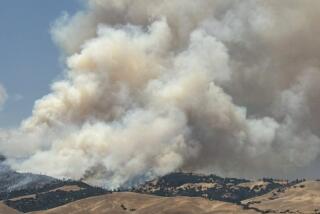Dear Street Smart:This may be a bit...
- Share via
Dear Street Smart:
This may be a bit out of your territory, but I turn to you as one who knows all.
When a major accident takes place on Interstate 5 through the mountains north to Bakersfield, many refer to the freeway as “the Grapevine.”
I always understood the Grapevine was the Grapevine Canyon leading from Ft. Tejon to the floor of the San Joaquin Valley.
Which is it?
Cliff Dektar, North Hollywood
Dear Reader:
At the risk of sounding like a politician, Street Smart must answer that both you who refer to the canyon and those who refer to the freeway as the Grapevine are correct.
The stretch of I-5 that straps together Los Angeles and Kern counties is indeed known as the Grapevine to the motoring public. And presumably, it got the name from the topographical feature you cited: nearby Grapevine Canyon, a small pocket north of Lebec on the steep downhill grade that ushers you into the San Joaquin Valley.
The canyon earned its name in 1806, when Spanish Lt. Francisco Ruiz dubbed it Canon de las Uvas because of the abundance of Cimarron grapevines in the area, says Gary Onyshko, an attorney and unofficial historian at Tejon Ranch.
It was more than a century later that the freeway was built and got its nickname. “There were some old wives’ tales that it got its name (because) the road twisted its way down the canyon, like a vine, but there’s no confirmation of that,” Onyshko says.
But trying to define the boundaries of the Grapevine freeway stretch--at least its southern end--is more confusing.
Most seem to agree that the northern terminus is the tiny community of Grapevine at the base of the hill, on the Kern County side.
On the south, says Lt. Dan Pankey at the California Highway Patrol’s Ft. Tejon office, the cutoff is technically around Gorman, on the edge of Los Angeles County and close to the top of the incline.
Unofficially, however, many use the term “Grapevine” loosely to encompass the entire Tejon Pass, from Castaic all the way over the hill. This broader definition may come from the CHP itself, Pankey says.
It seems that CHP officials, who issue traffic updates to radio and television broadcasters, wanted to get away from using “Tejon Pass” for that long stretch because people often misheard the first word and mixed it up with the Cajon Pass on Interstate 15 way out by San Bernardino.
So the CHP now commonly substitutes “the Grapevine” for the Tejon Pass.
Dear Readers:
Speaking of the Grapevine, which was shut down at some points last week because of heavy snow, we at Street Smart think it’s a good time to review tips for safe driving during wet winter conditions (courtesy of traffic guru Kenny Morse).
* Slow down. Snow can cause you to skid, and rain can cause you to hydroplane, which snatches the car completely from your control and renders your brakes useless.
* Know how to handle a skid. Always turn the wheel in the direction of the skid, and do not slam on the brakes (unless you have an anti-lock braking system). For example, if the rear of the car is careening to the left, turn the steering wheel toward the left.
* Check your tires. Make sure they are inflated to the right pressure and that you have enough tread. Morse suggests the Lincoln penny test: Stick a penny in the tread, and if it’s not deep enough to cover Lincoln’s head, get new tires.
* Avoid very deep puddles. Pools of water higher than your tires can knock out your engine.
* Carry emergency gear. Always stock emergency items in your car, such as a flashlight, blanket, sturdy walking shoes, umbrella, a tire inflation kit and flares.
More to Read
Sign up for Essential California
The most important California stories and recommendations in your inbox every morning.
You may occasionally receive promotional content from the Los Angeles Times.













